ABOUT ACACについて
Messageご挨拶
青森公立大学 国際芸術センター青森(ACAC)は、八甲田山麓のダイナミックな自然と特徴的な建築が生み出す環境を活かし、アーティスト・イン・レジデンス(滞在制作、AIR)、展覧会、教育普及を3つの柱として、現代芸術の多様なプログラムを発信するアートセンターです。青森市市制100周年記念事業として設立され、2001年12月に開館しました。現在は青森公立大学が運営しています。
招へい、公募、自主滞在問わず表現者の創造的活動の支援、優れた芸術の発信、活動が生み出すつながりによる国際的ネットワークの構築、市民や学生とアーティストの出会いや表現・学びの機会の提供などを通して、地域内外へと波及する文化芸術の創造・発信の中心(センター)であることを目指しています。また、春から秋にかけては敷地内の森の散策や、20数点を数える野外彫刻の鑑賞もお楽しみいただけます。
当センターの設計は安藤忠雄によるものです。周囲の自然環境を生かし起伏に富んだ地形を壊さないように配慮し、建物を森に埋没させる「見えない建築」をテーマとし、谷沿いに橋が架かるようなイメージの直線型の創作棟と宿泊棟、さらにギャラリーや円形の屋外ステージを備えた馬蹄型の展示棟の3棟から構成されています。この独特の建築空間は、滞在するアーティストの新しい想像力をかきたて、また訪れる人にとって、刺激的な新しい芸術体験の場となるでしょう。
The Aomori Contemporary Art Centre (ACAC) is a contemporary art institution nestled in a dynamic natural environment on the foothills of the Hakkoda Mountains. Its distinctive architecture is well-suited to the center’s three creative pillars of artist-in-residence (AIR) programs, exhibitions, and education/learning programs. Established as a project to commemorate the 100th anniversary of the founding of Aomori City, the ACAC opened its doors in December 2001 and is currently run by Aomori Public University.
The ACAC is committed to fully supporting creative pursuits regardless of the artist-in-residence, whether by nomination, open call, or paid residency. Our aim as an institution is to further communicate excellence in contemporary art, construct international networks through these connections, and provide new encounters and learning opportunities between artists and residents and students in the local community. From spring to autumn, you can appreciate more than 20 outdoor sculptures on premises as you enjoy a walk through the ACAC’s lush forest.
The ACAC’s architectural design is the work of internationally acclaimed architect ANDO Tadao. Careful to exploit the surrounding natural environment without upsetting the undulating topography, Ando was inspired by the concept of “unseen architecture,” effectively burying the complex deep in the woods. The ACAC is made up of three main buildings: the linear Creative and Residential Halls, which were designed to resemble bridges hugging the mountainside, and the horseshoe-shaped Exhibition Hall, which is equipped with a gallery and an outdoor amphitheater. These unique architectural spaces can help unlock creativity within the artists who stay here, and the ACAC aims to provide new and stimulating art experiences for all who visit.
Architectural Information建築案内
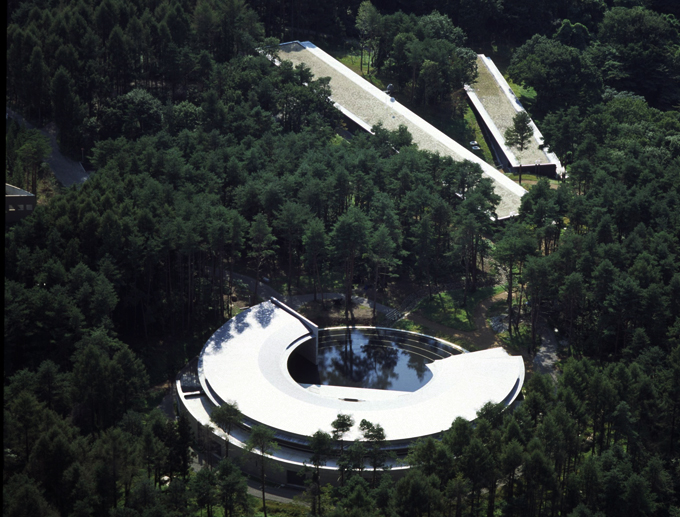
建物全体を自然の中に埋没させる「見えない建築」をコンセプトに、2001年12月の開館に先駆け同年11月に建てられました。宿泊棟・創作棟・展示棟と3つの建物と四季のアーケードは、機能を固定しない「がらんどう」の空間としてアーティストを刺激し、雪といった自然環境も含めて全体が展示空間となるよう意図されています。さらに安藤は一貫して「育てる」という言葉で、建築のつくり手の限界と使用する人たちの創造的な可能性についても語っています。
カーブした壁をもち、窓からの自然光の入る特徴的なギャラリーだからこそ構想され・実現した作品も少なくありません。開館から変わらずアーティストの創造性を刺激してきました。一方、変わっていくこともあります。鏡のように磨かれたギャラリーの床には彫刻作品を固定した際に空いた穴や、天井に見える結露の跡など、その時の工夫や確かに経過した時間を建築は語っています。
ACACにはコレクション作品はありませんが、その時々に合わせて使用されてきた建築作品があると言えるのかもしれません。一人の建築家の作品としてだけではなく、使用する側の意図や、自然環境によっても日々変化が重なってきた場所なのです。
The ACAC’s architecture is based on the concept of “unseen architecture,” effectively burying its buildings in the forest. The architecture was completed in November 2001, just one month before it opened in December of the same year. The three buildings that make up the ACAC—the Residential Hall, Creative Hall, and Exhibition Hall—and its outdoor arcade are designed to be a blank canvas for artists to experiment and create new work, effectually an empty space with no fixed function. The entire space, including the surrounding natural environment and weather, including the snow in winter, is intended to be an exhibition space. ACAC architect ANDO Tadao consistently uses the word “nurture” when talking about the limits of the architect and the creative potential of the people who use the space.
Many of the works created at the ACAC were both conceived and realized with the arching walls and natural light of its unique gallery in mind. Since its opening, the ACAC has never ceased to inspire creativity in the artists who come here. The space has always been in a state of evolution. Its architecture tells a remarkable story of elapsed time and ingenuity throughout the history of the ACAC, from the holes in the polished gallery floor where a sculpture once stood to the traces of condensation that form on the ceiling.
While the ACAC may lack a permanent collection, the architecture is a kind of artwork in and of itself, one that sees use from time to time. The ACAC is not the work of a single architect. It is a place that transforms daily with the natural environment and the intentions of the people who use it.
安藤忠雄 略歴
1941年大阪生まれ。独学で建築を学び、1969年安藤忠雄建築研究所設立。代表作に「光の教会」「ピューリッツァー美術館」「地中美術館」など。1979年「住吉の長屋」で日本建築学会賞、1993年日本芸術院賞、1995年プリツカー賞、2003年文化功労者、2005年国際建築家連合(UIA) ゴールドメダル、2010年ジョン・F・ケネディーセンター芸術金賞、後藤新平賞、文化勲章、2013年フランス芸術文化勲章(コマンドゥール)、2015年イタリアの星勲章グランデ・ウフィチャ―レ章、2016年イサム・ノグチ賞など受賞多数。
Tadao ANDO
Born 1941 in Osaka, Japan. Self-taught in architecture. Established Tadao Ando Architect & Associates in 1969. Major works include the Church of the Light, Pulitzer Arts Foundation, and Chichu Art Museum. Awarded the Architectural Institute of Japan (AIJ) Prize for the Row House in Sumiyoshi in 1979, Japan Art Academy Prize in 1993, Pritzker Architecture Prize in 1995, Person of Cultural Merit (Japan) in 2003, International Union of Architects (UIA) Gold Medal in 2005, John F. Kennedy Center Gold Medal in the Arts in 2010, Shimpei Goto Award in 2010, Order of Culture (Japan) in 2010, Commander of the Order of Art and Letters (France) in 2013, Grand Officer of the Order of Merit (Italy) in 2015, and Isamu Noguchi Award in 2016.
建築ギャラリーPhoto Gallery
Outdoor Sculptures野外彫刻
国際芸術センター青森では、常設の展示室がない代わりに、敷地内に野外作品が点在しています。野外彫刻として作られた作品、アーティスト・イン・レジデンスで制作されその後しばらく残っている作品などが混在しています。自然豊かな森の散策と共にお楽しみください。
At the Aomori Contemporary Art Centre (ACAC), numerous outdoor sculptures dot the premises instead of a permanent installation gallery. Works are a mixture of those created as outdoor sculptures and those left on display temporarily by our artists in residence. Please enjoy them on your walk through the rich natural environment of the woods surrounding the ACAC.

*森の中は、場所によってぬかるんでいる場合があります。ご注意下さい。
*冬期は雪のため道が閉鎖されたり、雪に埋まっていたりするなどして作品が見えないこともあります。ご了承ください。
*強い風が吹いている時は、枝などが落下し危険ですので、森の中へは入らないでください。
*Please note that there may be muddy areas in the forest.
*Sculptures may be unavailable for viewing during the winter as roads may be closed or artwork may be buried under the snow. We ask for your understanding.
*Please do not go into the forest during windy conditions as falling branches can prove dangerous.
-
村岡三郎(1928- 大阪)MURAOKA Saburo (1928– Osaka, Japan)
現代彫刻の表現では、素材に意味をもたせることによって、私たちに何かを語りかけてくるような作品が多くある。この作品に使われている「鉄」と「塩」から何を想像するだろうか。塩が鉄を酸化させ、やがて朽ちていく姿か。この作品は自然環境の中で、物質が時を経て変化していく姿の在り様を示している。
In modern sculpture expression, there are many pieces which tell us something by giving meaning to their materials. What does the “iron” and “salt” used in this piece mean for you? Salt oxidizes the iron, perhaps to call up images of decay and rust. This sculpture indicates the transformative plight of matter, which changes its shape over time in a natural environment.
1《SALT》 Salt
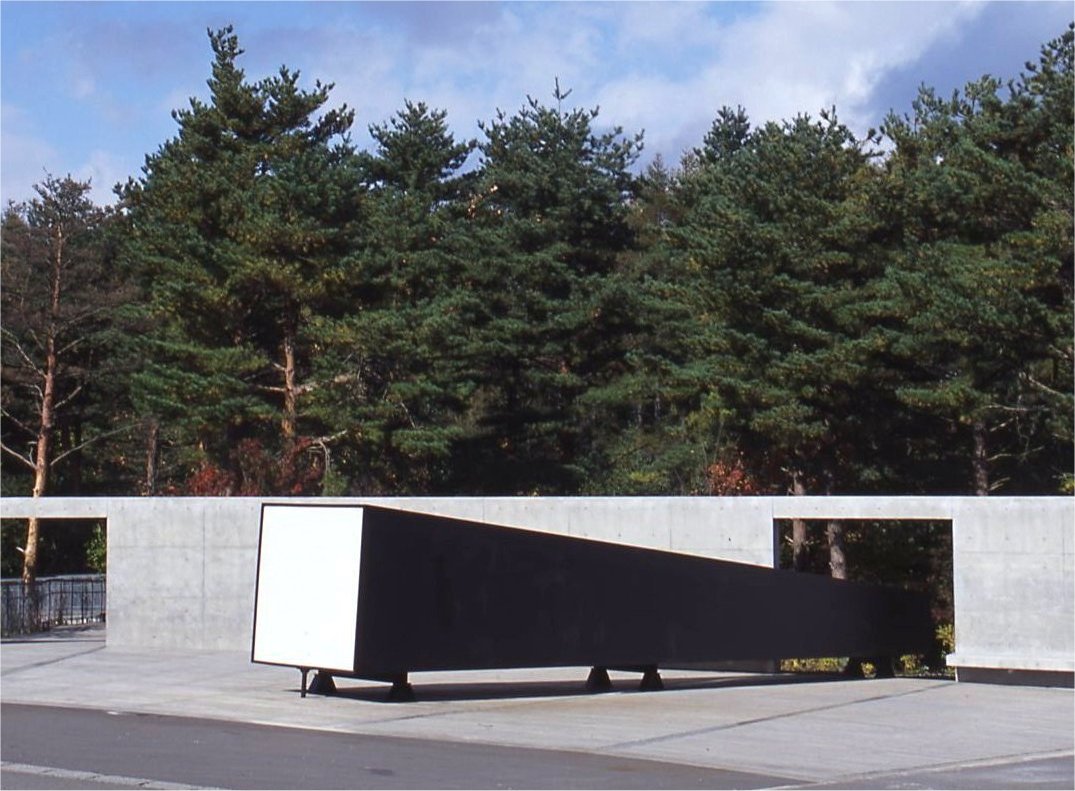
-
河口龍夫(1940- 兵庫)KAWAGUCHI Tatsuo (1940– Hyogo, Japan)
河口龍夫は時間や言葉など眼に見えないものと物質の関係についてずっと考えてきた。ACACの入口近くの見返り広場と水のテラス脇の小さな広場にブロンズの杖を1本ずつ埋めた。地面の底深くに堆積する縄文の時間を感じるためである。
見返り広場にはコンクリートの壁にブロンズの詩が刻まれ、もうひとつの「時間の庭」には鳥の巣箱や、7本の樹木にかけられた銅の輪やアクリルの階段が設けられた。それぞれ過去・現在・未来の時間に捧げられたものである。Tatsuo Kawaguchi has pondered the relationship between matter and things unseen, like time and language. He buried one bronze cane in the turnaround plaza near the ACAC entrance and one more in the small plaza to the side of the water terrace. This was in order to feel Jomon time accumulated deep under the surface. A bronze poem was etched into the concrete wall in the turnaround plaza, and bird houses and bronze rings were hung on seven trees in the “Garden of Time” and an acryl staircase installed. Each is a dedication to the past, present, and future of time.
2《関係-時の杖》 Relation—Wand of Time
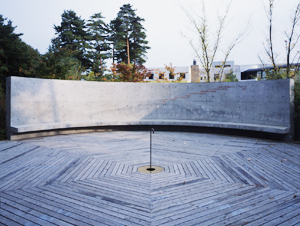
5《関係-時の庭》 Relation—Garden of Time
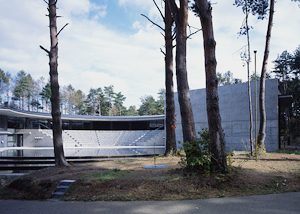
-
パル・ペーター(1961- ルーマニア)PAL Péter (1961– Romania)
この作品では、アナモルフォーシス(歪み絵)の技法が用いられている。地面に並べられた石畳は、歴史的遺物の象徴としてのアステカ時代の仮面が中央の鏡面状の円筒の表面に結像するように組まれており、歴史の長さと現在の儚さを対比させている。使われた石は主に青森県内の海岸で集められた。
This pieces implements two time-honored techniques: anamorphosis and methods of stone-paving often seen in old European towns. The various types of stones arranged on the ground recalls images of masks of Pre-Columbian Mesoamerica and displays them as mirror images.
3《アナモルフォーシス3(歩ける彫刻)》 Anamorphosis III, The sculpture you walk on
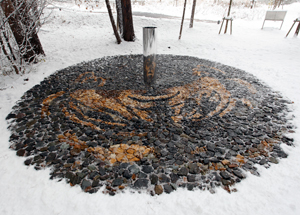
-
鈴木正治(1919- 青森)SUZUKI Masaharu (1919- 2008, Aomori, Japan)
2002年春AIR参加。 青森の自然と関わりあいながら生きている人間としての感性を形(石)におきかえることを作品制作の動機とし、自然のままの石の大きさ、形、質を生かしながら、そこにさらなる自然を表現する。表から見ると八甲田山が彫りこまれているこの作品の裏側にはまるでねぶたの送り絵のように、鈴木の代表的なモティーフの一つ、馬にまたがる裸婦、レディ・ゴディバの伝説が刻まれている。
The motive for this production was to give shape to the sensitivity of people living in harmony with Aomori’s nature through stone, exploiting its natural size, shape, and quality to further depict nature. From the front, Hakkoda-san has been carved out, but from behind is “Godiva”, a motif representative of Suzuki’s work. The naked woman astride a horse is based on the legendary ride of Lady Godiva.
4《八甲田山》 Mt. Hakkoda
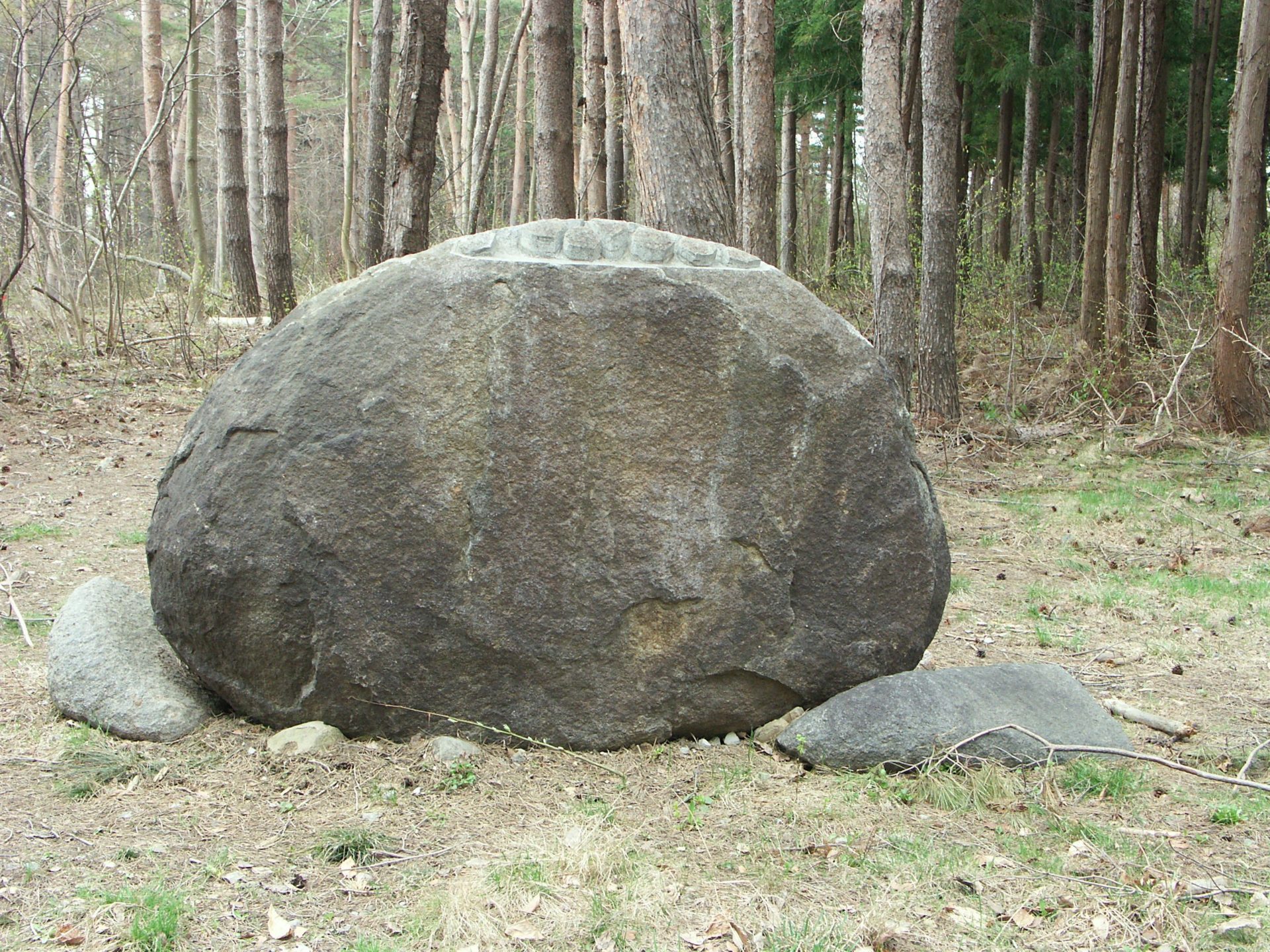
-
バラニ・ゾルターン(1971- ハンガリー)BALANYI Zoltán (1971– Hungary)
石との精神的つながりに重きを置くバラニは、制作においては常に石との精神的な対話を行い、石が望む形に作品を作り出すと語る。展覧会に出品した「はめ込まれた丸石」(Embedded Pebbles)シリーズとして制作されたこれらの作品は、バラニの一貫したテーマである自然に守られている人間の姿、あるいは自然との共存が表れている。
Marc Barani attaches a great deal of importance to emotional connection with stone. He shares that he is in constant nonverbal communication with stone and this enables him to create pieces in the stone’s desired shape. These three pieces produced as the “Inlayed Boulder” series and displayed in the exhibition express Barani’s theme of humanity being protected by and coexisting with nature.
6《共存》 Coexist
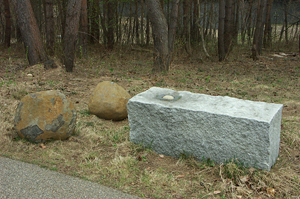
15《丸石のある石壁とテーブル》 Stone wall and table with pebbles
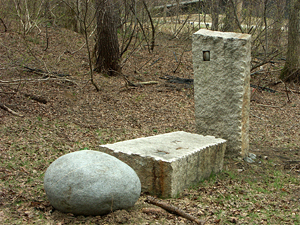
-
シム・ムンセプ(1942- 韓国)SHIM Moon-Seup (1942– Korea)
7メートルもの半割の松ノ木と御影石(花崗岩)を組ませて作った水路である。水は石や木の表面を伝わり流れて元に戻る。始めも終わりもない永遠の循環は生命の流れをつなげる環である。生に近い素材を組み合わせた形態は、舟のような橋げたのような、建築の礎台のような、生活の中で見慣れたものを想わせる。
This is a water channel created by combining a 7-meter halved pine tree and granite. The water runs down the surface of the wood and returns again in an endless cycle. This eternal cycle, without beginning or end, is a ring connecting the flow of life. The configuration of near-alive materials is like a small boat or bridge beam or architectural cornerstone.
7《プレゼンテーション》 Presentation
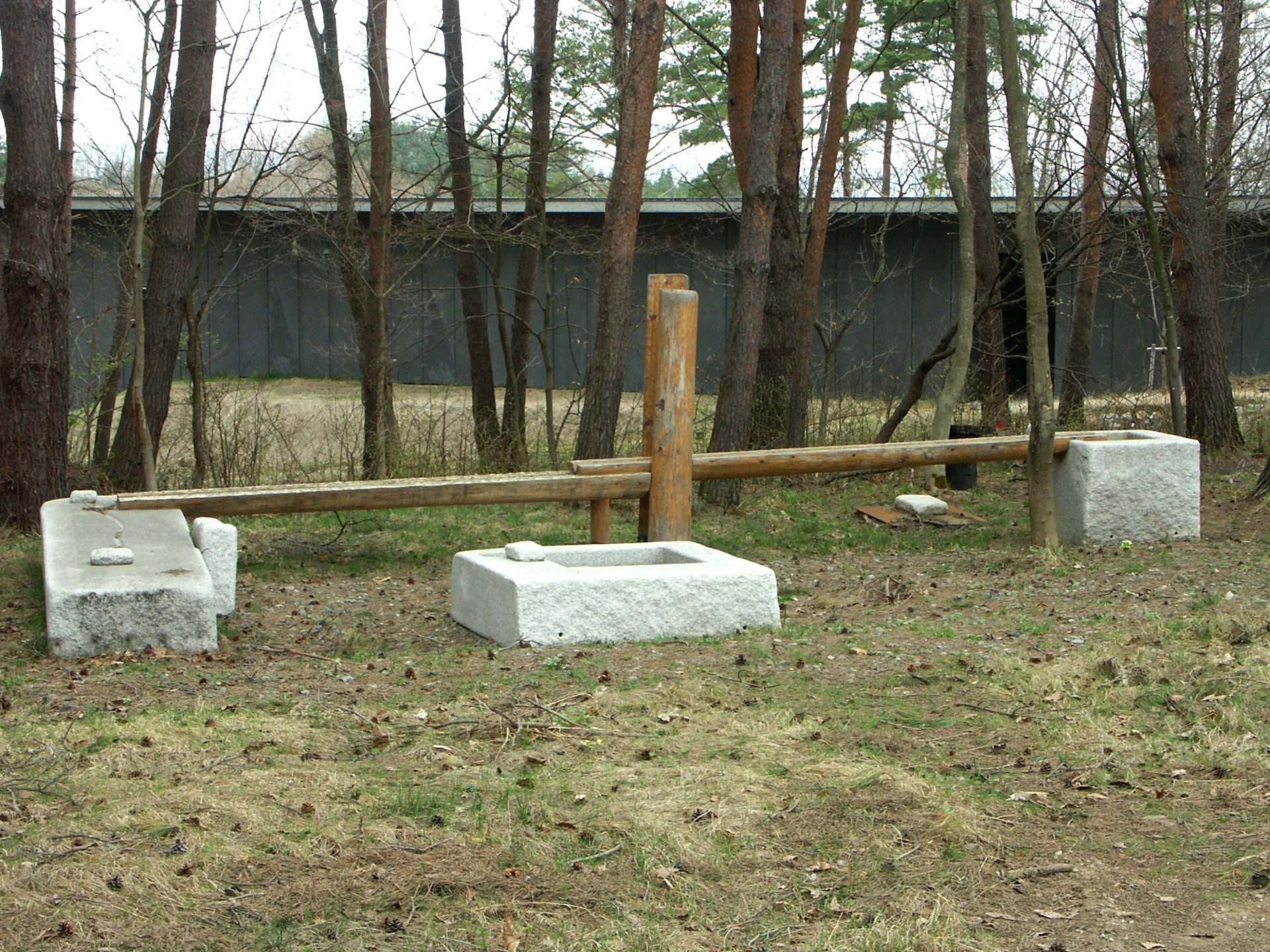
-
若江 漢字(1944- 神奈川)WAKAE Kanji (1944- Kanagawa, Japan.)
豊かな自然の中に、突然、人工物であるステンレスの壁が立っている。あえて人工的なものを置くことによって、自然はより豊かに、またステンレスは人工としての美しさがそれぞれ際立ってみえてくる。壁には赤い文字で「Non Ultra(超えるべからず)」、青い文字で「Plus Ultra(超えていけ)」という、相反するふたつの言葉がネオンサインとなって掲げられている。
In the midst of rich nature, all of a sudden a man-made stainless wall appears. By putting something artificial here, both nature and the wall stand out distinctly; nature appears more abundant and the stainless steel is more beautiful in its artificiality. On the wall are neon signs with the conflicting words “Non Ultra” in red and “Plus Ultra” in blue.
8《森にある壁》 The Wall in woods
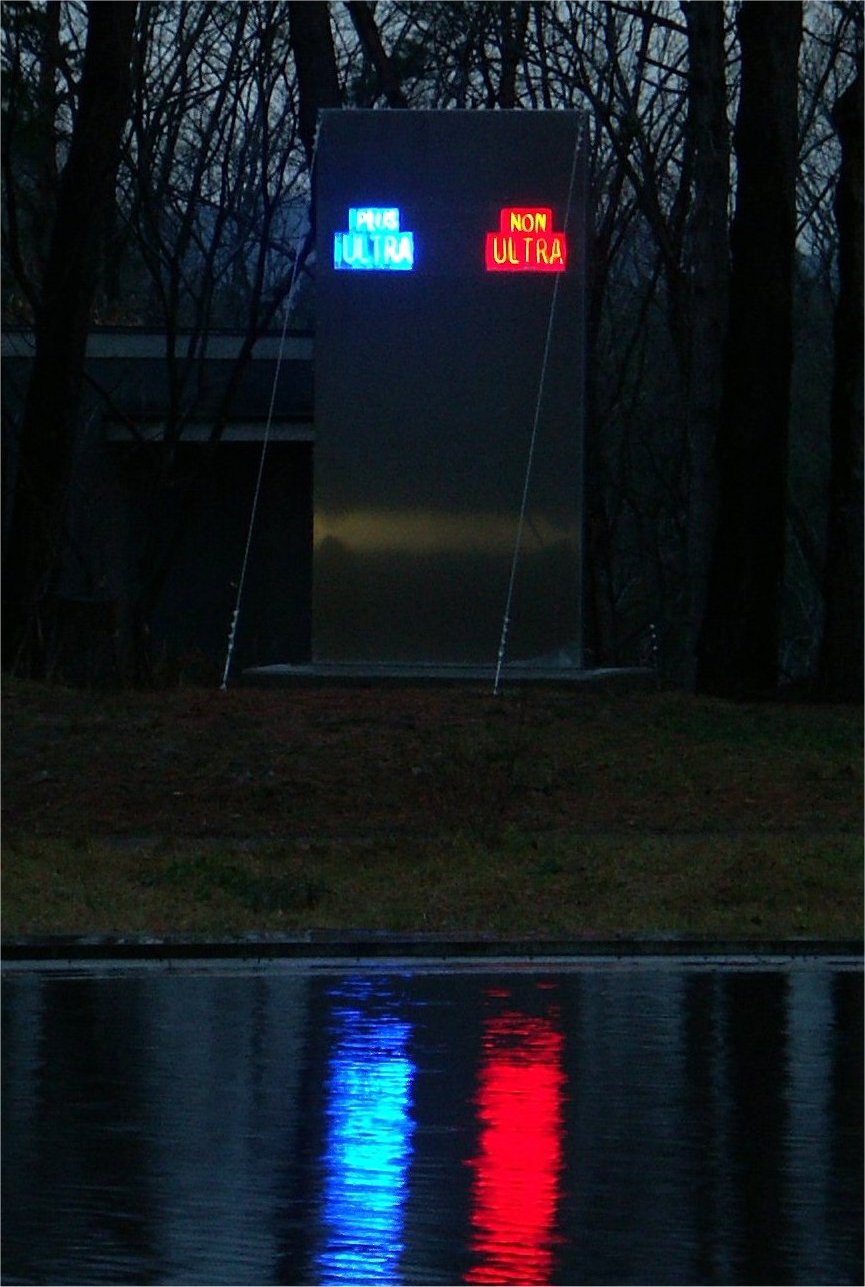
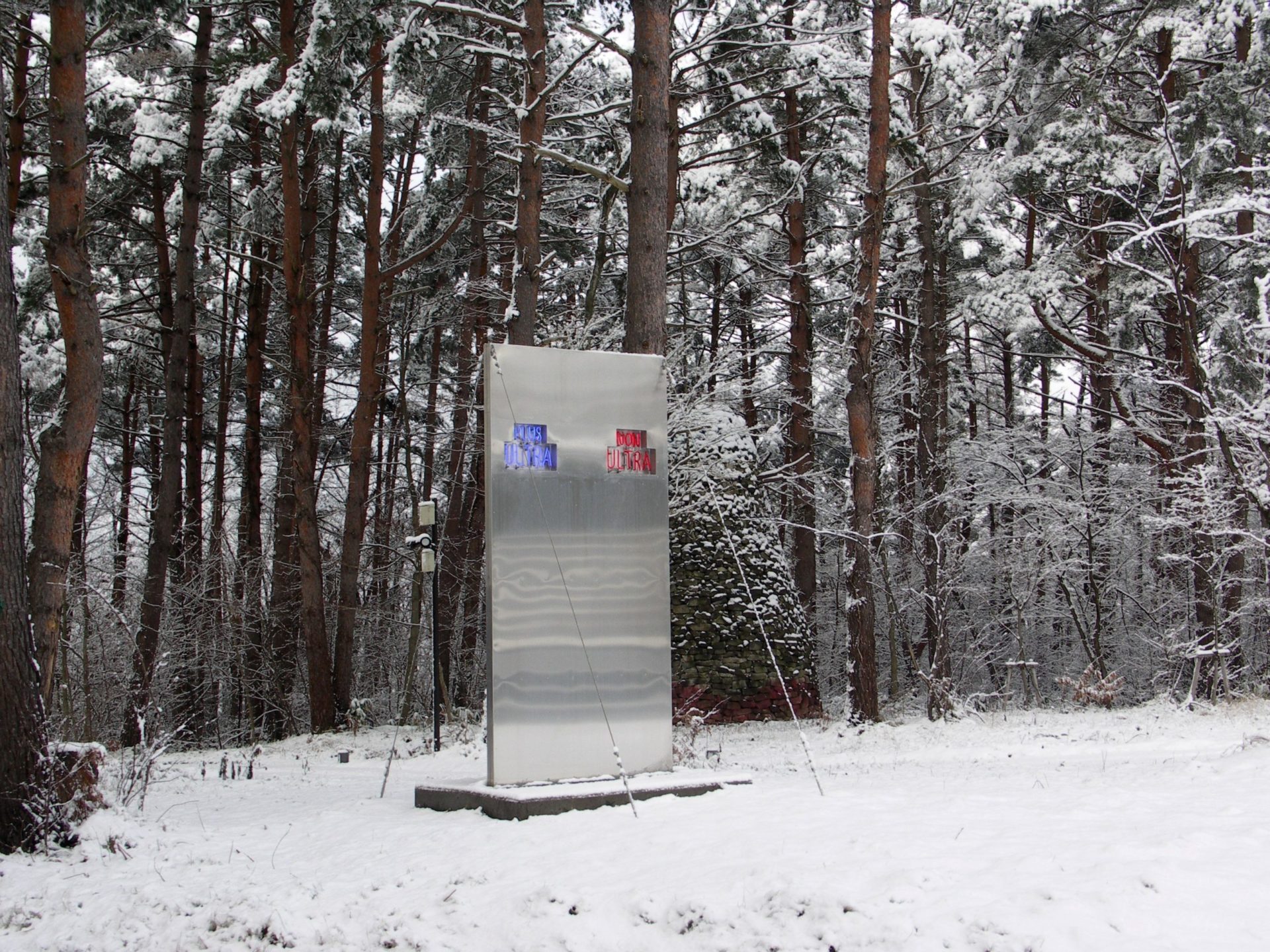
-
イ・ソンテク(1932- 韓国)LEE Seung-Taek (1932- Korea.)
この作品は1988年に青森で開かれた青函EXPO’88 記念「現代野外彫刻展」において入選作品として合浦公園に残されたものである。当時はふたつの形に分かれていたが、13年後にACACに移設されたときに、この森の環境に合わせてひとつにまとめられた。再生された現在の形は高さ7m、直径4mとなった。自然と同化した古い塚のような姿は、人間と自然の長い歴史とその末の調和のあり方を考えさせる。
This is a prize-winning piece in the “Contemporary Outdoor Sculpture” genre left in Gappo Park during the Seikan Expo ’88, which was held in Aomori in 1988 to celebrate the opening of the Seikan Tunnel, which connects Honshu and Hokkaido. At the time, this piece was divided into two shapes, but was united into one when moved to the ACAC 13 years later after discussions with the artist. It was created in the shape of a towering bullet by accumulating crushed stone fragments quarried near Aomori City. Its current shape is 7 meters tall and 4 meters in diameter. Six cylindrical bronze pipes stick out of the top, into which deadwood from the surrounding forest is inserted.
9《作られた自然》 Artificial Nature
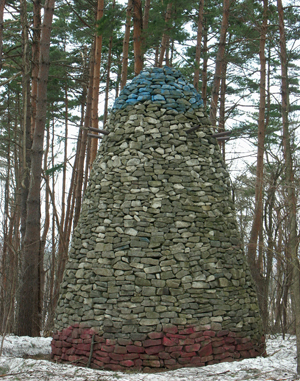
-
中瀬 康志(1955- 青森)NAKASE Koji (1955- Aomori, Japan.)
細く長い形がお父さん、やや太く低い形がお母さん。この作品は、青森出身の中瀬が、自身の父を亡くし、望郷の思いを抱きつつも、それを乗り越え、自分自身で立ち上がり生きていこうとする決意を示す。また、この一対の男と女を表す姿は、生命のはじまりである人間の根元的な姿(アダムとイヴのように)ともとらえられる。
The skinny, long one is the father, and the slightly thicker, shorter one is the mother. This pair of man and woman can be interpreted as humanity’s original form and the beginnings of life, as if Adam and Eve.
10《グッバイ・パパ、グッバイ・ママ》 Good-bye papa, good-by mama
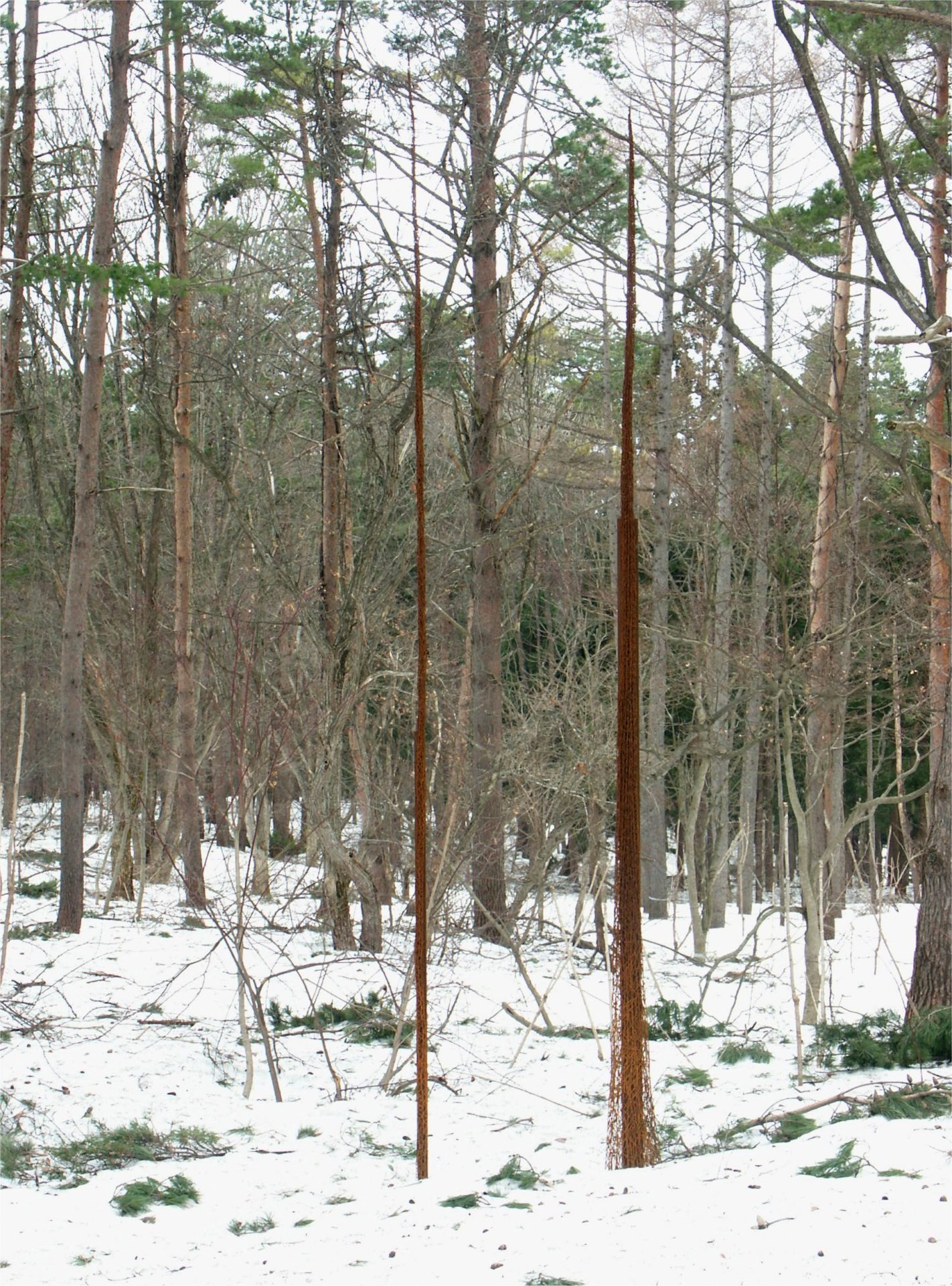
-
辻けい(1953- 神奈川)TSUJI Kei (1953– Kanagawa, Japan.)
2005年の最初の制作時、作品の内壁には辻が染めた色鮮やかな糸が張られていた。2017年の再制作で、辻はその上から自然顔料のベンガラのあかを塗った。円筒形の作品は、内部の音を複雑に反響させる。それは訪れる人々の内から響く音のようでもあり、こだまのような森からの応答のようでもある。
When Tsuji first created this work in 2005, she hung vividly dyed threads all around the inner walls. Remaking the work in 2017, Tsuji painted over the threads with bengala, a natural red pigment made from iron ore. This cylindrical work creates complex echoes from the sounds produced inside its walls, as if they were the reverberations of the visitors’ inner thoughts, or even the spirits of the surrounding forest calling out in response.
11《青森 - 円2005・2017》 AOMORI - Circle 2005・2017
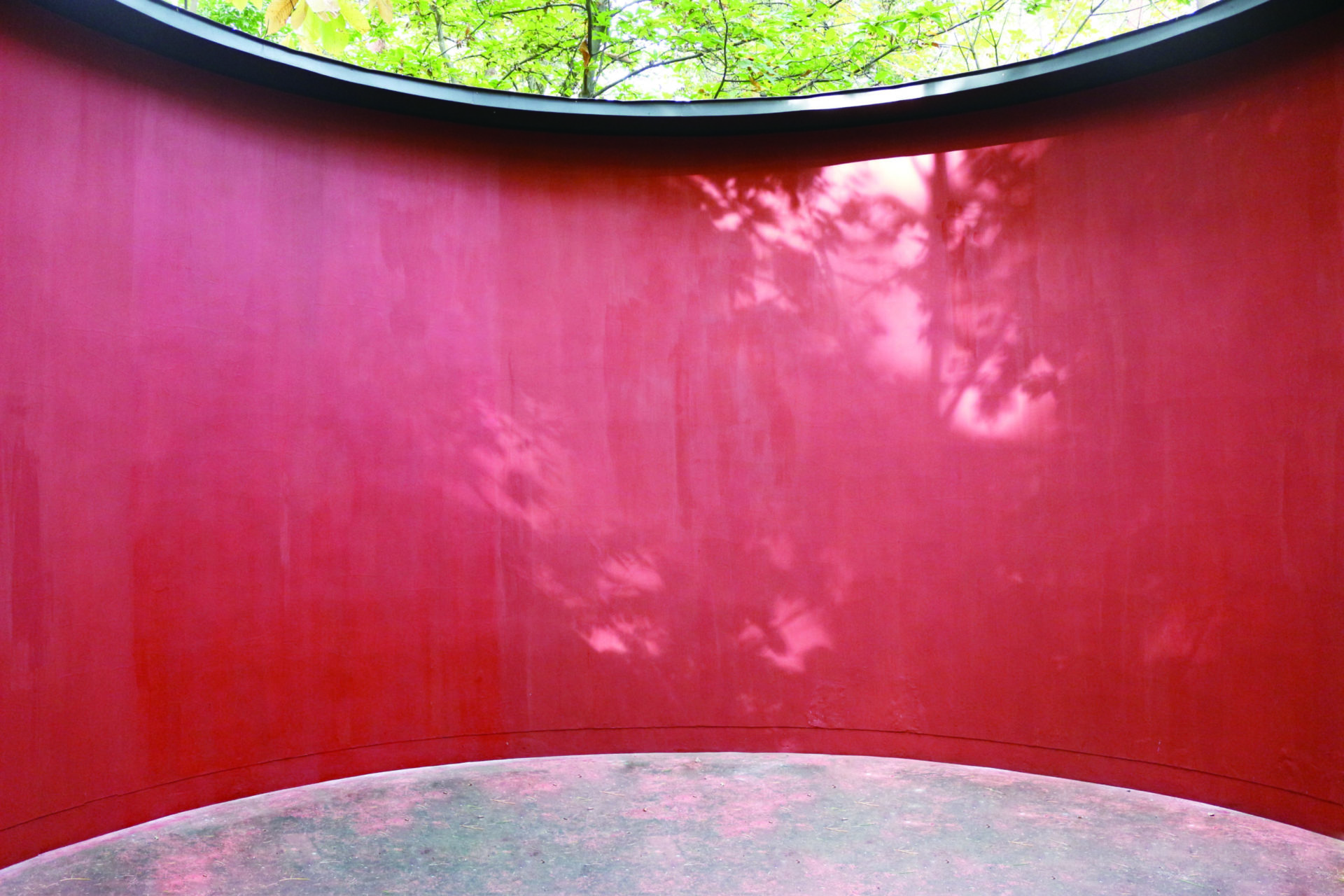
-
青木野枝(1958- 東京)AOKI Noe (1958- Tokyo, Japan.)
溶断されたバリの残る鉄を繰り返し積み重ねることで、鉄彫刻でありながらも空気感と軽やかさを併せ持つ作品を特徴とする。空気、水蒸気、放射能といった目には見えないけれども確かに存在するものへの関心と、青森の土地で作家が感じた光や影や空気の揺らぎが重なり合ってこの作品を生まれた。現在この「雲谷」シリーズは、静岡、山口などでも展開されている。
This piece is characteristic of being both an iron sculpture and also brings a sense of atmosphere and lightness, which was brought about by repetitively stacking malleable iron after being melted first. It was born to excite an interest in unseen but very real things such as air, vapor, and radiation, while inspired by the overlapping of lights, shadows, and air currents felt by the artist during her stay in Aomori.
12《雲谷 -Ⅰ》 Moya - I
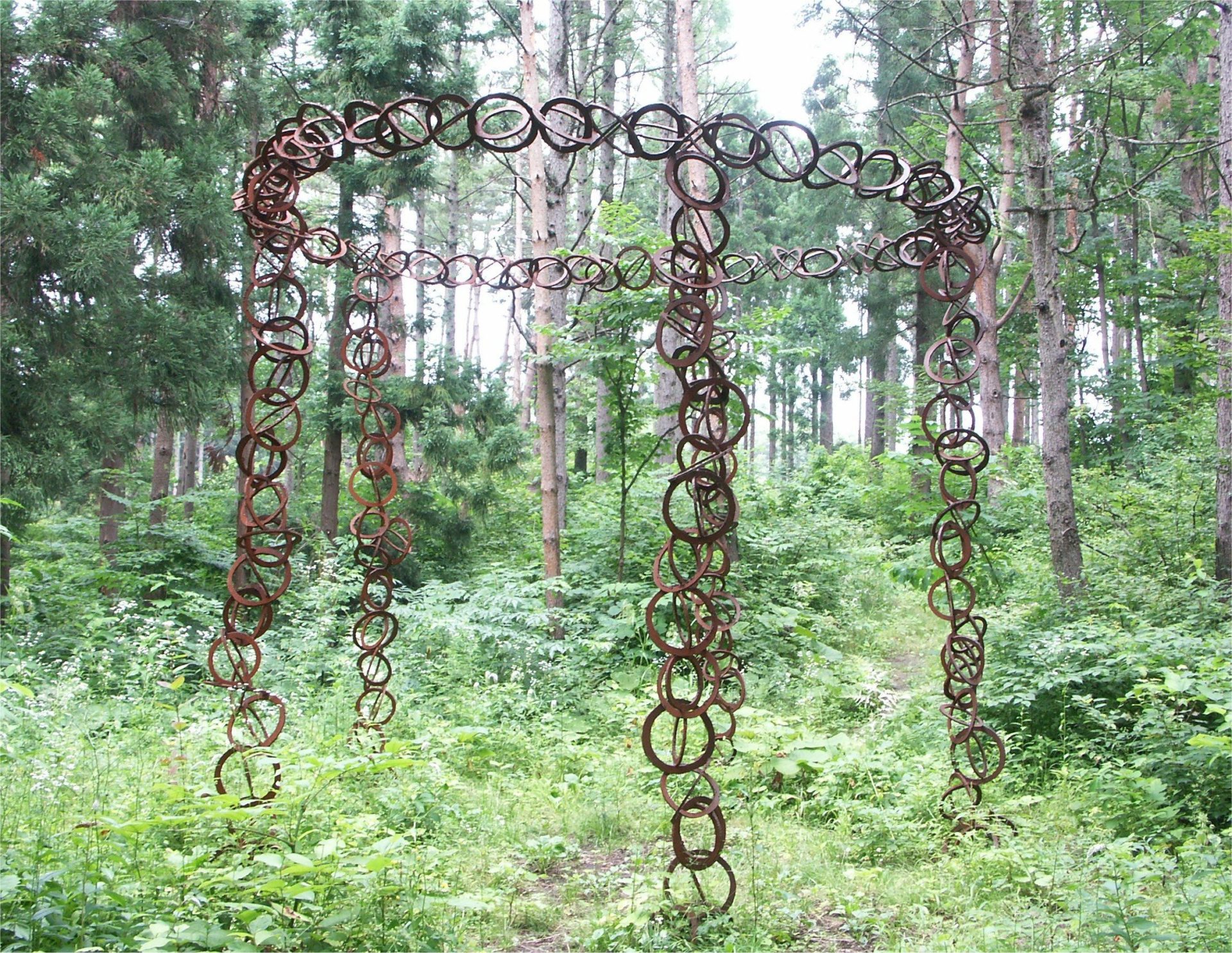
-
植松奎二(1947-, 神戸)UEMATSU Keiji (1947– Kobe, Japan.)
関西を拠点に活動を始め、一貫して重力や引力、張力など空間の中に存在するあらわには見えない関係を作品によって見せる試みを続けている。樹木や石など自然の要素と金属の形態を組み合わせ、不思議な均衡関係で立っている円錐形や螺旋の彫刻をつくる。ここでは森の奥深くに1本だけステンレスの木を立て、その周りの地面に螺旋形の土手を築いた。
Based in Kansai, UEMATSU Keiji has been engaged in production between Dusseldorf and Kansai since 1974. He continues to create works which illustrate scantly seen relationships that exist in space, such as tension or gravity and its pull. His conical or spiral sculptures combine natural elements like wood and stone with metal configurations to strike an enigmatic balance. Here a single stainless-steel tree stands deep in the woods with a spiral bank surrounding it.
13《樹とともに-宙》 With a tree - Cosmos

-
石岡豊美(1948- 青森)ISHIOKA Toyomi (1948- Aomori, Japan.)
素材のもつ風合い、個性を生かし、自然と芸術の調和的な作品を作り上げる。巨大なヒバの抜根を使って制作された彫刻は、独特の有機的なフォルムを生かした作品となっている。1999年より青森市沢山地区に展開するアートフォーラムに参加、中心的メンバーとして活躍する。
Utilizing the material’s texture and unique characteristic, ISHIOKA Toyomi creates pieces harmonious between art and nature. His sculpture using the stump of a huge Japanese cypress exploits a unique organic form. Since 1999, he has been active as a central member of the “Sawayama Art Property Project”, an art forum expanding in the Sawayama area of Aomori City.
14《無題》 Untitled
-
土屋 公雄(1955- 福井)TSUCHIYA Kimio (1955- Fukui, Japan.)
物質に宿る人間の記憶をテーマとする。340本もの枕木を使ったこの作品は、遠くに見える山並みと向かい合いながら、森をうねるフェンスのような形をしている。古い枕木は、かつて本州の終着駅であった青森の鉄道の歴史を思い起こさせる。地を這って働き続けてきた枕木は、今その役目を追え、人々の生活を森の中から静かに見守っているようだ。
The human memory which resides in material objects has been the theme of much of Kimio Tsuchiya’s work. This piece, which uses 360 railroad ties, faces the distant mountains while shaped like a meandering fence through the woods. The old railroad ties trace their roots to former Aomori Station, previously the last stop on Honshu.
16《記憶の風景》 Landscape recollection

-
コーネリア・コンラッズ(1957- ドイツ)Cornelia KONRADS (1957- Germany.)
川を挟んで向かい合う2つの出入り口のない家は、地中に半分埋まっているが、夜になると部屋の明かりが灯る。「家」のような国や地域の特徴をとらえた建物を、不気味だがどこかユーモラスに表現することで、安定と不安、安心感と疎外感の両方を感じさせる「家」を作りあげている。
If you walk down the hill from the Creative Hall to the Residential Hall, you will find two intriguing houses facing each other across the river. Although half of these entrance-less houses are buried in the ground, both safety and insecurity dwell there when illuminated at night.
17《隣人たち》 Neighbors
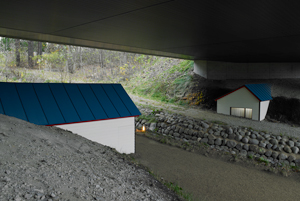
-
淺井裕介(1981- 東京)ASAI Yusuke (1981– Tokyo, Japan.)
道路の横断歩道や「止まれ」の印などに用いられるのと同様の白線素材(クイックシート)を用いた作品。シート状になった白線素材をその場所を利用する人々と一緒に植物のかたちに切り出し、そのパーツを淺井が路上などに丁寧に並べて構成し、最後にバーナーで焼き付けて完成させた。
This piece utilizes the same white line material (quick sheet) used for crosswalks and stop signs on the pavement. Yusuke Asai and individuals who use that space cut out the white line material sheet into the shape of plants, which Asai later carefully laid out onto his chosen surface (roads, etc.) to create a composition. Lastly, he used a burner to affix the image and complete the piece.
18、19、20、21、22《植物になった白線@ACAC》 Sprouted Plant@ACAC
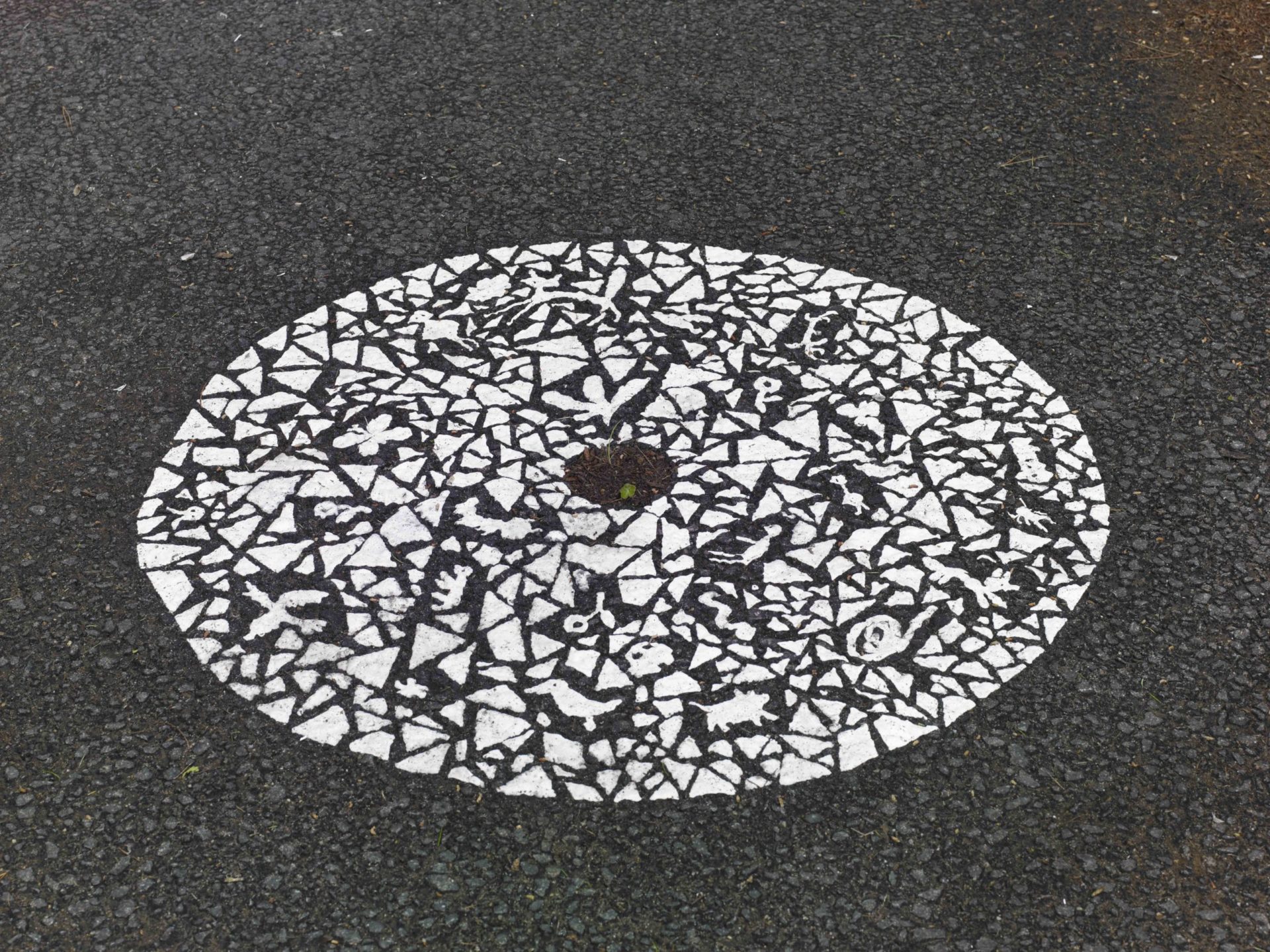

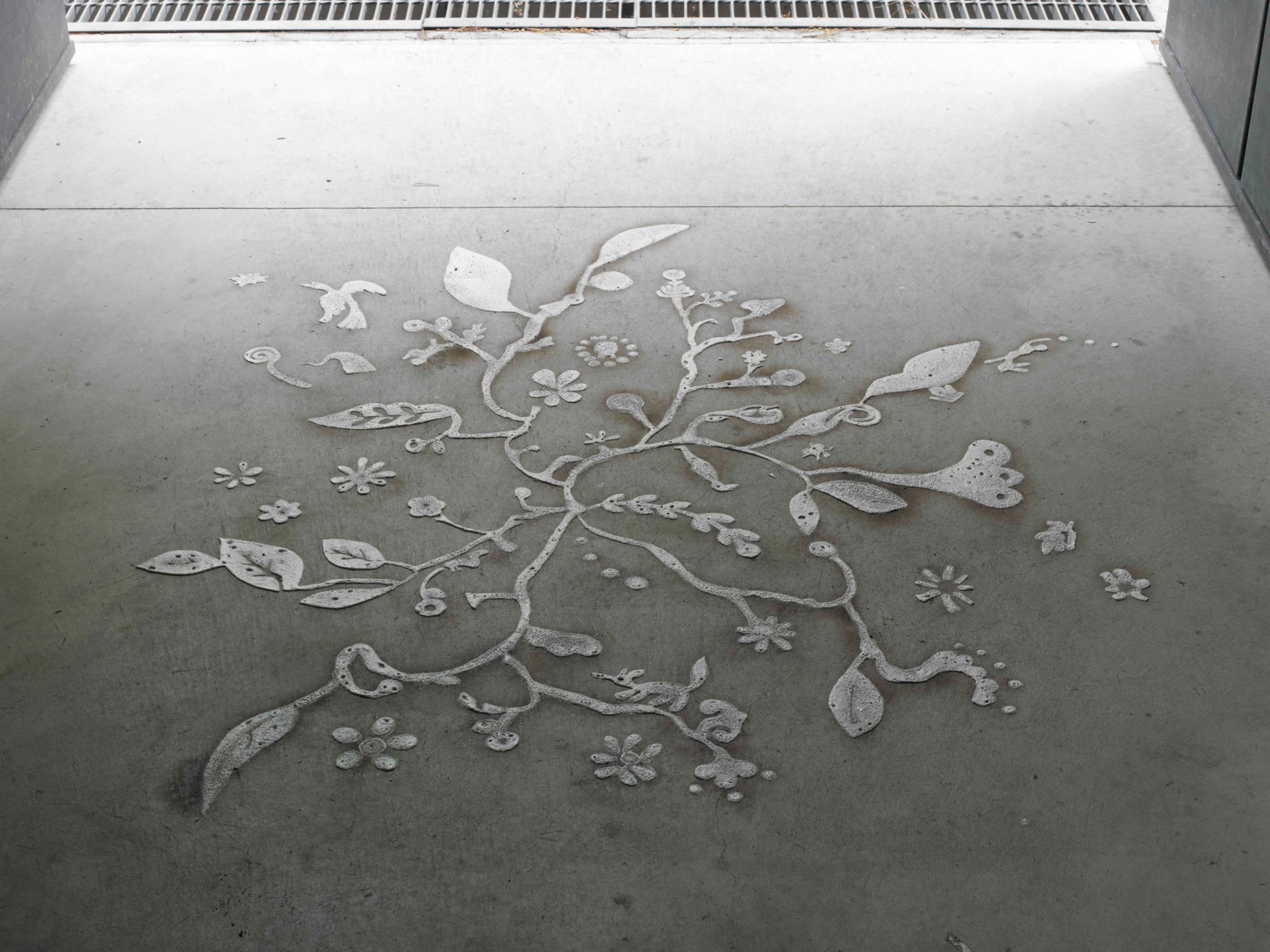

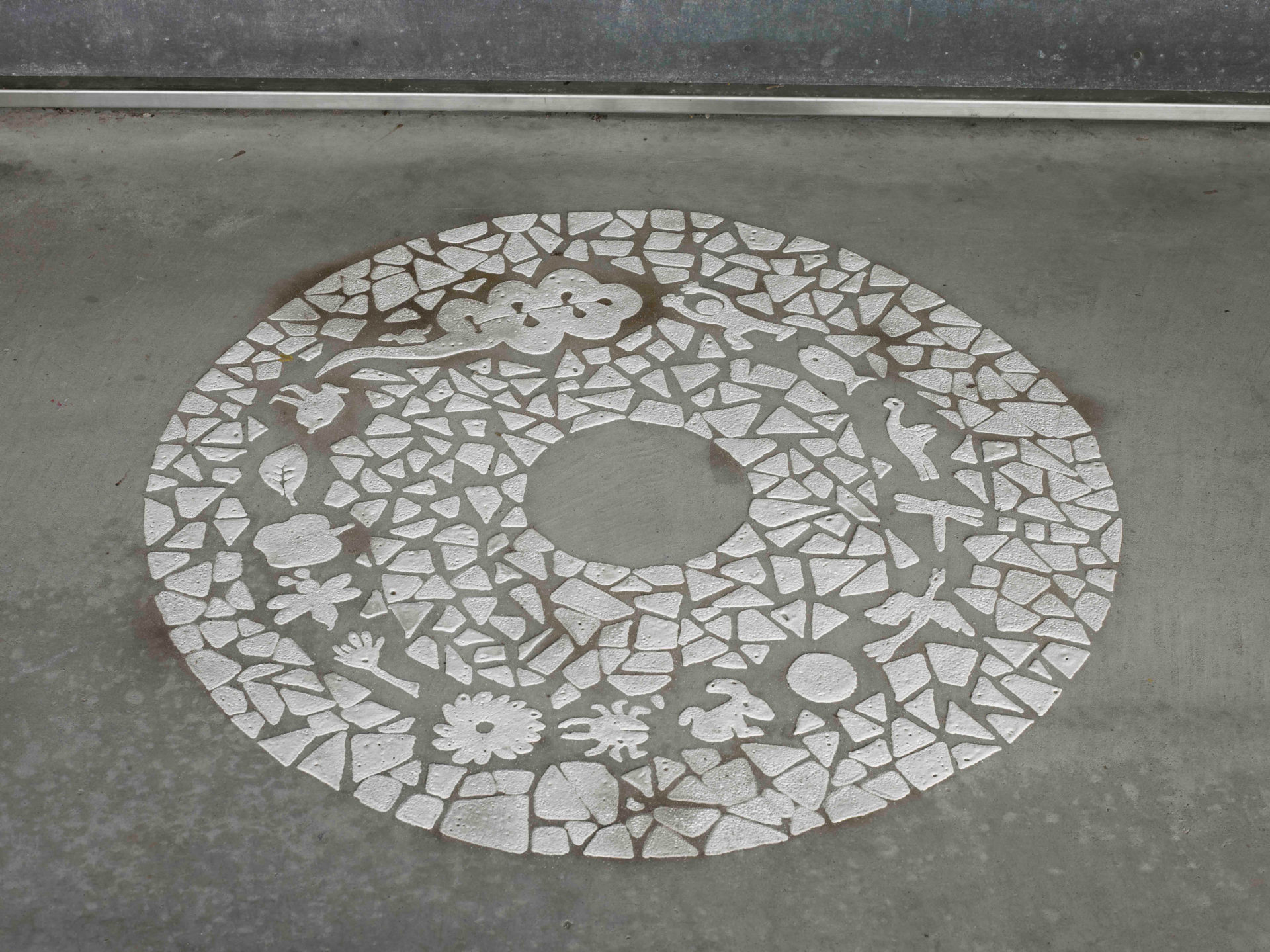
Nature自然
ACACの敷地内で見られる野鳥をご紹介します。
写真提供、野鳥特定:工藤正義
You can find many kind of wild birds on the premise of ACAC.
Photo and distinction of each bird by KUDO Masayoshi
Staffスタッフ紹介
-
服部 浩之HATTORI Hiroyuki館長Director
1978年愛知県生まれ。早稲田大学大学院修了(建築学)後、秋吉台国際芸術村に3年半、国際芸術センター青森[ACAC]に6年半勤務し、約10年アーティスト・イン・レジデンスに携わる。フリーランスを経験後、秋田公立美術大学美術学部アーツ&ルーツ専攻・大学院複合芸術研究科を経て、現在は東京藝術大学大学院映像研究科メディア映像専攻准教授。一貫して芸術文化が生まれ育つ場所に関心をもちアートセンターや教育機関を軸としながら、半公共・コモンズ・横断性などをキーワードに様々な表現者との協働プロジェクトを展開する。携わったプロジェクトに、アートサイト名古屋城2024「あるくみるきくをあじわう」(2024年、名古屋城)、「200年をたがやす」(2021年、秋田市文化創造館)、第58回ヴェネチア・ビンナーレ国際美術展日本館展示「Cosmo-Eggs|宇宙の卵」(2019年)、「近くへの遠回り」(2018年、ウィフレッド・ラム現代美術センター)、あいちトリエンナーレ2016「虹のキャラバンサライ 創造する人間の旅」(2016年、愛知県美術館ほか)などがある。近年は季節の変化を身体的に実感できるACACの森があるからこそ可能な藝術実践を探求中。
Born in 1978 in Aichi, Japan. After completing master in architecture at Waseda University, he worked for three and a half years at the Akiyoshidai International Art Village, followed by six and a half years at the Aomori Contemporary Art Centre (ACAC), engaging with artist-in-residence programs for approximately ten years. After a period as a freelance curator, he worked for Akita University of Art’s Department of Arts and Roots and its Graduate School of Transdisciplinary Arts, and is currently an Associate Professor at the Graduate School of Film and New Media, Tokyo University of the Arts. Throughout his career, he has consistently focused on the environments where art and culture are nurtured. Centering his work around art centers and educational institutions, he develops collaborative projects with artistic practitioners focusing on the themes such as semi-publicness, commons, and transversality. His recent projects include: “Found Perspectives for Tasty Sightseeing” at Art Site in Nagoya Castle 2024 (Nagoya Castle, 2024), “Cultivating Successive Wisdoms” (Akita City Cultural Creation Center, 2021), Japan Pavilion exhibition “Cosmo-Eggs” at the 58th International Art Exhibition – La Biennale di Venezia (2019), Going Away Closer” (Centro de Arte Contemporáneo Wifredo Lam, 2018), “Homo Faber: A Rainbow Caravan” at the Aichi Triennale 2016 (Aichi Prefectural Museum of Art and other venues). Currently, he is exploring artistic practices that are made possible by the rich living environment of the ACAC forest—where one can physically experience the changing seasons.
-
瀬藤 朋SETOU Tomo学芸員Curator
京都府生まれ、札幌育ち。大阪大学文学研究科アートメディア論コース修了。在学中は、インドにおけるパフォーマンスアートの実践について研究を行う。特に公共空間でのパフォーマンスが多く行われる背景や原動力に関心を持ち、デリーとコルカタでアーティストやパフォーマンスアートフェスティバルへの取材を行った。株式会社precog アーティスト事業部 プロジェクトアシスタント、京都芸術センター アートコーディネーターを経て2024年より現職。パフォーミングアーツ作品やイベントの企画制作、アーティスト・ イン・レジデンス(AIR)の企画、審査、コーディネートに携わる。これまでの主な企画として、第156回 明倫茶会「e 野点 (い~のだて)」(2024年 京都芸術センター)、KAC Performing Arts Program Daichi Yamamoto「watch your step」(2024年 京都芸術センター)、台北パフォーミングアーツセンターとのAIRエクスチェンジプログラム(2022-2023年、京都芸術センター)、表現のコモンズ vol.10 敷地理×イリナ・グリゴレ「身体が透明になるまで」(2025年、国際芸術センター青森)等。ACACでは、公募AIRの運営、海外拠点のAIR団体との協働プログラム、教育普及等を担当。青森に来てからラテンダンスを習い始めた。
Born in Kyoto and raised in Sapporo. Completed the Arts and Media Studies program at the Graduate School of Letters, Osaka University. She has conducted research on performance art practices in India, with a particular interest in the performances held in public spaces. She undertook field research in Delhi and Kolkata, interviewing artists and covering performance art festivals. After working as a Project Assistant at precog Inc. and as an Art Coordinator at Kyoto Art Center, she started to work for ACAC in 2024. Her work involves producing and directing performing arts works, as well as organization and coordination of Artist-in-Residence (AIR) programs. After moving to Aomori, she enjoys learning Latin dance. Her major past projects include: The 156th Meirin Tea Ceremony “E~Nodate” (Kyoto Art Center, 2024), KAC Performing Arts Program Daichi Yamamoto “watch your step” (Kyoto Art Center, 2024), the AIR exchange program with Taipei Performing Arts Center (Kyoto Art Center, 2022–2023), and Creative Commons vol.10 SHIKICHI Osamu× Irina Grigore “until the body becomes transparent” (Aomori Contemporary Art Centre, 2025). At ACAC, she is responsible for managing open-call AIR programs, relating with AIR organizations overseas, and overseeing educational and outreach activities.
-
原田 桃望HARADA Momomi学芸員Curator
2022年、京都芸術大学大学院美術研究科グローバル・ゼミ修了。在学中は国立国際美術館の学芸インターンや関西クィア映画祭の実行委員として活動する。大学院修了後はアートスペースPURPLEの立ち上げから関わり、2年間ギャラリー業務を専任する中で、写真を中心とした数々の展覧会やイベントの企画・運営に携わる。2024年4月より現職。写真・映像・本を介した場づくりに関心を持ち、イベントや展覧会企画、執筆活動を行っている。ACACでは「アーティスト・イン・レジデンス プログラム2024 “SPINNING SCAPES”」や「ACACの写真部」(2024-25年度)などを担当している。これまでの主な企画として、読書会「波をかさねる」(2022–24、PURPLE)、ミーティングポイント四条烏丸(2023、KYOTO EXPERIMENT 京都国際舞台芸術祭)、rajiogoogoo「泣き子党事務所」(2022、KIKA gallery)、「20世紀の写真芸術」(2017、大阪府立江之子島文化芸術創造センター(enoco))等。また、2024年にはクィア理論をベースに写真家・岡部桃の作品分析を行った修士論文から『岡部桃『イルマタル』試論─クィア写真を媒質として─』を刊行。
Completed studies at Kyoto University of the Arts in 2022. While at university, engaged in a curatorial internship at the National Museum of Art, Osaka and participated as a member of the executive committee for the Kansai Queer Film Festival. After completing graduate studies, became involved from the launch of the art space PURPLE and spent two years dedicated to gallery operations, taking part in the planning and management of numerous exhibitions and events, with a focus on photography. Current position since April 2024. Interested in creating spaces through photography, video, and books, and is engaged in curating events and exhibitions, as well as in writing activities. At ACAC, is responsible for projects such as Artist in Residence Program 2024 “SPINNING SCAPES” and “Aomori Contemporary Photo Club” (FY2024–25).
Major projects to date include: Book Club, “Weaving Waves” (PURPLE, 2022–24), Meeting Point Shijo Karasuma (KYOTO EXPERIMENT, 2023), rajiogoogoo, “Crying Children Party’s Office” (KIKA gallery, 2022), “ART PHOTOGRAPHY IN THE TWENTIETH CENTURY” (Enokojima Art, Culture and Creative Center, Osaka Prefecture, 2017), etc. In 2024, published “Towards Queer(ing) Photographyas a Medium: On Momo Okabe’s Ilmatar”, based on a master’s thesis that analysed the work of photographer OKABE Momo through the lens of queer theory. -
大黒優香OKURO YukaアートコーディネーターArt coordinator
2018年、中央大学総合政策学部卒業。2018年より公益財団法人 福武財団に6年間勤務し、地中美術館の運営、エデュケーターとして対話型鑑賞のファシリテーションやアート鑑賞を軸とした教育プログラムの企画・開発などに携わる。人が集まる場づくり、とりわけ子どもたちの「第三の居場所」としての美術館・アートセンターの在り方に関心があり、学校をはじめとする教育機関や地域の方々との協働で小学校から高校、フリースクール等の生徒たちを対象とした鑑賞プログラムを設計・実践してきた。2024年11月より現職。アーティスト・イン・レジデンス(AIR)プログラムの運営や鑑賞ツールの開発を担当。これまでの主な企画として、「自分だけの問いに出合う 高校生フィールドワークin直島」(2024、福武財団)、note連載企画「体験者インタビュー」(2024、福武財団)、アジア・アート・プラットフォーム2022協同展「Communal Spirits/共に在る力」(サイトC、D)(制作補助として/2022、瀬戸内国際芸術祭2022)、地中美術館キッズ向け特別企画「ひみつをさがそう」(2020、福武財団)など。趣味は和太鼓。
Graduated from Chuo University, Faculty of Policy Studies in 2018. She had worked for Fukutake Foundation for 6 years since 2018, managing Chichu Art Museum, facilitating interactive art appreciation, and planning and developing several types of educational programs based on art appreciation as an educator. She is interested in creating spaces for people to gather, especially museums and art centers as a “third place” for children and has designed and implemented art appreciation programs for students from elementary to high school and free schools in collaboration with schools and other educational institutions and local residents. Current position since November 2024. She is in charge of the management of Artist in Residence (AIR) Program and the development of art appreciation tools. Major projects to date include: “Meet your own personal questions – High School Student Fieldwork in Naoshima” (Fukutake Foundation, 2024), an educational program for high school students; ”Participants Interview“ (Fukutake Foundation, 2024), a serial project in Note; and Asia Art Platform 2022 Cooperative Exhibition “Communal Spirits” (Site C, D) (as a production assistant/ 2022, Setouchi Triennale 2022), “Let’s look for a secret” (Fukutake Foundation, 2020), a special program for kids at Chichu Art Museum, etc.
-
木下雄二KINOSHITA Yuji技術員Technician
1994年、奈良県生まれ。愛知県立芸術大学大学院美術研究科油画・版画領域修了。愛知県を拠点に活動後、2023年から現職。映像や版画など、複数のメディアを横断する形で作品制作を行う傍ら、日本の美術館・芸術祭の作品設営に携わっている。展示技術としては、木工加工と作品梱包が得意。主な展覧会に、「グレーゴル」(2024年、G CRADLE)、「別様に、別の言葉で」(2022年、see saw gallery + hibit)、「国際芸術祭あいち2022」(2022年、愛知芸術文化センター)※縄(愛知県芸チームinitiated by 奈良美智)ディレクターとして参加、「Lagrangian Point -Telepathy-」(2019年、Gallery PARC)など。主な展覧会設営として、国際芸術センター青森[ACAC]では「アーティストインレジデンスプログラム2024 SPINNING SCAPES」、「currents/undercurrents -いま、めくるめく流れは出会って」、「エナジー・イン・ルーラル2023」など。外部での展覧会設営では、「荒木悠 LONERY PLANET」(2023年、十和田市現代美術館)、「吹けば風」(2023年、豊田市美術館)、「Reborn-Art Festival 2022」(2022年、日本製紙旧社宅)など。
Born in Nara in 1994. He completed graduate degree in oil painting and printmaking course at Aichi University of the Arts. After being based in Aichi, he started to work ACAC in 2023. While creating works using cross multiple media such as video and printmaking, also works as a installer and technician for museums and art festivals in Japan. As a installer, especially skilled in woodworking and artwork packing. His main exhibitions include: “Gregor” (2024, G CRADLE), “Divergently, in different language” (see saw gallery + hibit, 2022), “Aichi Triennale 2022” (Aichi Arts Center, 2022) *Participated as a director of Collective NAWA (Aichi Kengei Team initiated by Nara Yoshitomo), “Lagrangian Pont -Telepathy-” (Gallery PARC, 2019) etc. His main exhibition installations include: ”AIR Program 2024 SPINNING SCAPES”, “currents / undercurrents: Bringing together the endless flow”, “Energies in Rural 2023” at Aomori Contemporary Art Centre (ACAC), “Yu Araki: LONERY PLANETS” (Towada Art Center, 2023), “Incoming Breezes” (Toyota Municipal Museum of Art, 2023) , 2022 “Reborn-Art Festival 2022” (Former Nippon Paper Company Housing, 2022) etc.
-
慶野 結香KEINO Yuka主任学芸員Chief Curator